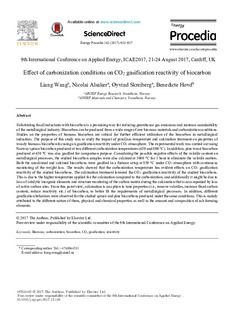| dc.contributor.author | Wang, Liang | |
| dc.contributor.author | Alsaker, Nicolai Etwin | |
| dc.contributor.author | Skreiberg, Øyvind | |
| dc.contributor.author | Hovd, Benedicte | |
| dc.date.accessioned | 2018-02-02T08:23:11Z | |
| dc.date.available | 2018-02-02T08:23:11Z | |
| dc.date.created | 2017-08-27T16:30:20Z | |
| dc.date.issued | 2017 | |
| dc.identifier.citation | Energy Procedia. 2017, 142 932-937. | nb_NO |
| dc.identifier.issn | 1876-6102 | |
| dc.identifier.uri | http://hdl.handle.net/11250/2482305 | |
| dc.description.abstract | Substituting fossil reductants with biocarbon is a promising way for reducing greenhouse gas emissions and increase sustainability of the metallurgical industry. Biocarbon can be produced from a wide range of raw biomass materials and carbonization conditions. Studies on the properties of biomass biocarbon are critical for further efficient utilization of the biocarbon in metallurgical industries. The purpose of this study was to study the impact of pyrolysis temperature and calcination treatment on properties of woody biomass biocarbon focusing on gasification reactivity under CO2 atmosphere. The experimental work was carried out using Norway spruce biocarbon produced at two different carbonization temperatures (650 and 800 °C). In addition, pine wood biocarbon produced at 650 °C was also gasified for comparison purpose. Considering the possible negative effects of the volatile content on metallurgical processes, the studied biocarbon samples were also calcined at 1000 °C for 1 hour to eliminate the volatile matters. Both the uncalcined and calcined biocarbons were gasified in a furnace setup at 850 °C under CO2 atmosphere with continuous monitoring of the weight loss. The results showed that the carbonization temperature has evident effects on CO2 gasification reactivity of the studied biocarbons. The calcination treatment lowered the CO2 gasification reactivity of the studied biocarbons. This is due to the higher temperature applied for the calcination compared to the carbonization, and additionally it might be due to loss of catalytic inorganic elements and structure reordering of the carbon matrix during the calcination that is accompanied by loss of active carbon sites. From this point view, calcination is an option to tune properties (i.e., remove volatiles, increase fixed carbon content, reduce reactivity etc.) of biocarbon, to better fit the requirements of metallurgical processes. In addition, different gasification behaviors were observed for the studied spruce and pine biocarbons produced under the same conditions. This is mainly attributed to the different nature of them, physical and chemical properties as well as the amount and composition of ash forming elements. | nb_NO |
| dc.language.iso | eng | nb_NO |
| dc.publisher | Elsevier | nb_NO |
| dc.rights | Attribution-NonCommercial-NoDerivatives 4.0 Internasjonal | * |
| dc.rights.uri | http://creativecommons.org/licenses/by-nc-nd/4.0/deed.no | * |
| dc.title | Effect of carbonization conditions on CO2 gasification reactivity of biocarbon | nb_NO |
| dc.type | Journal article | nb_NO |
| dc.type | Peer reviewed | nb_NO |
| dc.description.version | publishedVersion | nb_NO |
| dc.source.pagenumber | 932-937 | nb_NO |
| dc.source.volume | 142 | nb_NO |
| dc.source.journal | Energy Procedia | nb_NO |
| dc.identifier.doi | 10.1016/j.egypro.2017.12.149 | |
| dc.identifier.cristin | 1488869 | |
| dc.relation.project | Norges forskningsråd: 228726 | nb_NO |
| dc.description.localcode | © 2017 The Authors. Published by Elsevier Ltd. This is an open access article under the CC-BY-NC-ND 4.0 license (http://creativecommons.org/licenses/by-nc-nd/4.0/) | nb_NO |
| cristin.unitcode | 194,66,35,0 | |
| cristin.unitname | Institutt for materialteknologi | |
| cristin.ispublished | true | |
| cristin.fulltext | original | |
| cristin.qualitycode | 1 | |

